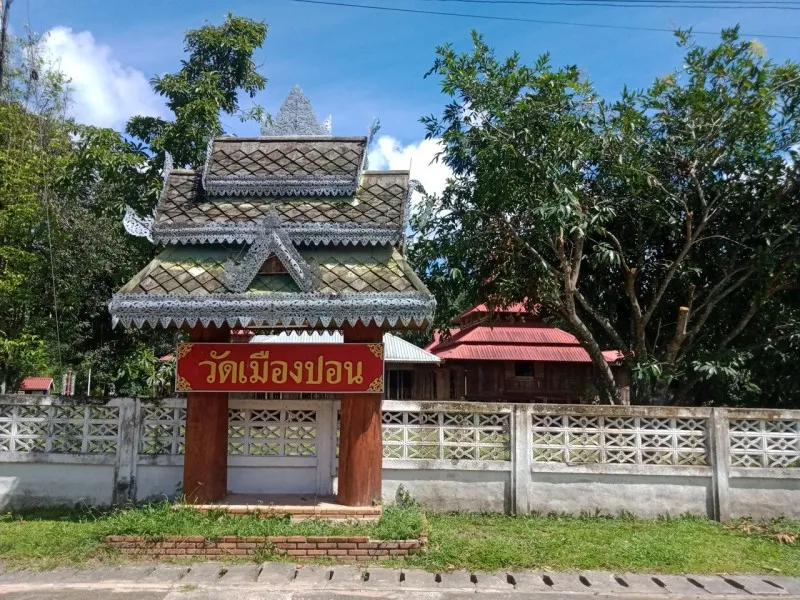Wat Muang Pon

Rating: 4.1/5 (10 votes)
Mae Hong Son attractions
Attractions in Thailand
Operating day: Daily
Operating time: 08.00 - 17.00
Wat Muang Pon Attractions in Mae Hong Son Muang Pon, Khun Yuam, Mae Hong Son. Wat Muang Pon is affiliated with the Mahanikaya sect and features several religious structures, including an ordination hall (ubosot), a sermon hall (sala kan prian), monks' residences (kuti), a prayer hall (ho suat mon), and a multipurpose pavilion. Sacred objects within the temple include a principal Buddha statue and Burmese-style artistic paintings.
The temple was established in 1867 (B.E. 2410). According to its history, the founders were Phra Yanoi Si Paisan, the ruler of Muang Pon, and Nai Jong Mong, a wealthy villager, together with the residents of Muang Pon. They initially built the prayer hall (jong para) and the sermon hall in 1854 (B.E. 2397). Later, in 1873 (B.E. 2416), Nai Terk Ong donated a kuti (monks' residence). The temple received the Royal Decree of Wisungkhama Sima on February 1, 1946 (B.E. 2489).
The temple has had numerous abbots over the years. Phra Okhong served from 1854 to 1862 (B.E. 2397–2415), followed by Phra Tintam from 1873 to 1877 (B.E. 2416–2420), and Phra Kan from 1877 to 1888 (B.E. 2420–2431). Other notable abbots include Phra Kruba No (1888–1902, B.E. 2431–2445), Phra Yan Sri Siriyano (1902–1911, B.E. 2445–2454), Phra Kaew (1911–1918, B.E. 2454–2461), and Phra Sawat (1918–1923, B.E. 2461–2466). Phra Panya led the temple from 1923 to 1934 (B.E. 2466–2477), followed by Phra Thanom (1934–1942, B.E. 2477–2485), Phra Sang Lee (1942–1950, B.E. 2485–2493), Phra Teng Han (1950–1956, B.E. 2493–2499), and Phra Maha Phai (1956–1962, B.E. 2499–2505). Phra Arin served from 1962 to 1965 (B.E. 2505–2508), followed by Phra Kasem (1965–1970, B.E. 2508–2513), and Phra Khru Suphacharakun (1970–1984, B.E. 2513–2527). The current abbot, Phra Amorn Vajirajitto, has held the position since 1985 (B.E. 2528).
Wat Muang Pon is home to the Tai Yai Museum and is a historic temple deeply rooted in the community. Its architecture reflects traditional Tai Yai style, with the vihara, kuti, and sermon hall interconnected under a single wooden roof. The roof design features double-tiered ridges and three-layered eaves, a style known as "double-ridge and triple-eave roofing." The vihara roof combines tiered roofing with spire-like elements, adorned with intricate wood or metal carvings, and features a decorative front gable with traditional carved patterns. Significant historic sites at the temple include a pavilion for bathing Buddha images, the ordination hall, Mon-Burmese-style Buddha statues, a pulpit stand, and ancient Tai Yai scriptures.
Comment
| Keyword (Advance) |
 Facebook Fanpage
Facebook Fanpage

 Category:
Category:  Group:
Group:  Art, Culture and Heritage
Art, Culture and Heritage Historical Sites and Monuments(
Historical Sites and Monuments( Landmarks and Memorials(
Landmarks and Memorials( Art, Craft Centres, Tradition(
Art, Craft Centres, Tradition( Museums(
Museums( Educational Places
Educational Places Educational Gardens, Farm(
Educational Gardens, Farm( Other religious and spiritural sites(
Other religious and spiritural sites( Research and Development
Research and Development Royal Project(
Royal Project( Suburban Living
Suburban Living Village, Community(
Village, Community( Local Market(
Local Market( Nature and Wildlife
Nature and Wildlife National Parks and Marine Reserves(
National Parks and Marine Reserves( Mountain (Doi)(
Mountain (Doi)( Dam, Reservoir, Lake(
Dam, Reservoir, Lake( Waterfalls(
Waterfalls( Hot Springs(
Hot Springs( Caves(
Caves( Flower Field(
Flower Field( River, Canal(
River, Canal( Other natural attractions(
Other natural attractions( Entertainment and Agricultural
Entertainment and Agricultural Farm, Parks, Gardens and Ecotourism(
Farm, Parks, Gardens and Ecotourism( Shopping
Shopping Shopping and Night Market(
Shopping and Night Market( Travel Articles, Recipes
Travel Articles, Recipes Travel Review, Food Review(
Travel Review, Food Review(